
Berger
History
by J.P. Whitelaw
As late as 1922, a sign bearing the name Berger could be seen swinging in front of a blacksmith's building near the gates to the old city of Stuttgart, Germany. It depicted two battle axes and an ironsmith's calliper above, and the title "The Forge" below. This sign announced the presence of a family business established in 1710 that originally manufactured swords, guillotines and armor. From Austria or perhaps Protestant France (Huguenots), the earliest Bergers were weapons makers for the royal family of Wurtemberg. Towards the middle of the nineteenth century Conrad Berger, whose family had by then abandoned the armaments business for agricultural tools, raised four sons at 15 Thor Strasse in Stuttgart. One of these was Christian Louis Berger (Figure 1), born in 1842, and the future founder of C. L. Berger Instruments.
It is unclear exactly how C. L. Berger moved from his ancestral interest in weapons, through his father's interest in farming implements, to his own devotion to the construction of precision mathematical and philosophical instruments. But in 1856, at age 14, he was apprenticed through the guild system to Christian Saeger, an established manufacturer of surveying instruments and analytical scales. In 1860 he worked with G. Shubart, an instrument maker for the University of Marburg. A year and a half later, he moved to Kassel, Germany, where for six months he studied with Breithaupt and Sons.
Highly Educated
In 1862 he returned to Stuttgart, luckily avoiding the military draft by drawing a high number, and became a foreman with the same Saeger company for which he had apprenticed. By 1866 the still young Berger, or, as he preferred to be called, Louis, had completed an additional year's study in mechanical technology at the Royal Polytechnic Institute, had learned techniques of adjusting precision scientific instruments with J. Lohmeyer of Hamburg, and had worked a further year and a half for A. G. Repsold, who enjoyed an international reputation for making transits, pendulums and equatorials. Berger completed his European education with Cooke and Sons of York, England.
Again, for reasons not well understood, Berger had been nurturing a desire to establish himself in America. So, despite protestations and offers of help from his father to set up his own business in Germany, he travelled to the United States aboard the steamer "City of Boston." Making his way to Boston, he found work with E.S. Ritchie of Brookline, Massachusetts, where for four years he made scientific and nautical instruments. He spent another year in John Upham's Philosophical Instrument Shop at Harvard Place.
On October 18, 1871, along with George L. Buff, another German who he had met in England while working with Cooke and Sons, Berger established his first business at No. 9 Province Court, Boston. Housed in a single room and specializing in surveying, engineering, mining and scientific instruments, the firm of Buff and Berger lasted until 1898. The company succeeded, expanding to occupy the whole building at No. 9 and most of the room at No. 7. It survived the Boston fire of 1872, but in the end would not survive its founders' disagreement about how many and which of the families' sons would be taken into the firm. It was originally agreed that each side of the firm would send one son to Germany to be educated in the business. George Buff had two sons—Karl and Louis. So did Louis Berger—William Albert and Louis Hermann. William A. Berger and Karl Buff were chosen and attended the Stuttgart factory of L. Tesdorph. The young Berger succeeded, as his original certificate from the City Tradeschool of Stuttgart in 1893 attests, and "did winter semester in 1893/94… studied trade drawing, and obtained…with very good behavior and hard work, … good progress…" Unfortunately, the Buff son did not develop as expected, so his brother Louis replaced him. Further disagreements about the future of the sons led to an acrimonious separation of the founders and the dissolution of the company in 1898.
There followed, according to William Berger, endless legal wrangles regarding alleged violations of patent rights and violation of a distinct clause that was designed to prevent Buff from re-entering the instrument manufacturing business for one year. Interpersonal conflicts continued through the litigation and eventually led to contempt of court charges. Interestingly, the schism was anticipated by Louis Berger as a few strictly-Berger-labelled instruments appeared before Buff and Berger was officially dissolved. The rift was irreversible, as was later reflected, for instance, in a 1922 volume of the National Magazine, where, in a biography of C. L. Berger titled "Dean of the World's Instrument Makers," there is no mention of either George Buff or the firm Buff and Berger.
Most Productive Period
Berger and his two sons acquired the assets of Buff and Berger, including everything from cash-on-hand through instrument stock to goodwill, and carried on the business in Province Court until 1902, when they moved the operation to 37 Williams Street in Roxbury. From then until 1922, the company made instruments for civil, geodetic, geological and petroleum engineers and surveyors. They diversified to produce special and unique instruments for scientists, particularly astronomers. Again according to William Berger, they were also involved in developing a ‘'technicolor camera projector" under the direction of Kalmus Comstock and Hestcots, which later became Technicolor. Equipped with a set of excellent dividing engines, this was arguably the most productive and influential period for Berger Instruments, and led to its association with academia and the publication of its unique and comprehensive catalogues.
According to a reported extract from the proceeding of the Meeting on Instruments of Precision, before the Society of Arts at the Massachusetts Institute of Technology in 1877, "There is no branch of mechanical arts which requires more skill in the use of tools, more geometric knowledge, or greater patience, than the construction of an automatic dividing engine." Berger inherited two from Buff and Berger, one built by Jesse Ramsden in London, and another made by William Wurdemann of Coast Survey fame, manufacturer of astronomical and geodetic instruments, and a fast friend of Berger's.
At the same time Berger was establishing important ties with the academic community in Boston, particularly with MIT and Professors Charles Breed and George Hosmer who co-authored an early standard surveyors' text (John Wiley and Sons). These volumes, first published in 1906, are liberally sprinkled with photographs and diagrams extracted directly from Berger Instrument literature, mostly the catalogues. Likewise, Philip Kissam's later text, "Surveying," (McGraw Hill, 1947) is also richly illustrated with Berger reference material, including photographs and a schematic diagram of one of the dividing engines. Indeed, in this text about 30 percent of the credited photographs or diagrams are Berger's, and reference to Berger Instruments can be seen in textbooks published as late as 1983. Berger was himself a prolific writer; in 1868 one of his letters regarding the use of aluminum for mathematical instruments appeared in Scientific American. He was also an occasional lecturer in New England universities and technical institutions. In exchange, schools enjoyed the privilege of class excursions to the Berger plant where they saw first-hand the process of quality instrument manufacture. There is even a suggestion that Alfred Einstein visited the facility in quest of precise astronomical instruments.
Catalogs A Wealth of Information
Of the early Berger legacy, it is perhaps the catalogues that are most revealing of the firm's founder. These unique catalogues not only describe the contemporary instruments and their specifications, but are also mini textbooks about the theory and practice of instrument design and surveying methods. One of the earliest has recently been republished by Dave Garcelon, who correctly states that the 1900 Handbook and Illustrated Guide of the Engineers' and Surveyors' Instruments of Precision is a "wealth of information about great American mathematical instruments." Part one includes, in addition to detailed instructions about the care of instruments, derivations of vernier formulae, derivations of gradienter trigonometric formulae and their adaptation to specific Berger instruments, and the theory of stadia measurement. There are contributions by professors of civil engineering at the University of Michigan and George Hosmer of MIT. Part two is an illustrated catalogue of the available instruments, generously illustrated with exquisite pen-and-ink drawings. Subsequent catalogues have a more modern style, but are still remarkable in their completeness. Berger appeared to have a special interest in mining transits of the kind illustrated in Figure 2 (generously given to the author by Cominco and the Sullivan Mine in British Columbia). There was a wealth of other available gadgets, including water current (flow) meters, reflecting circles, artificial horizons, pantographs, and planimeters. The company struck a medal with its trade marks on both sides. One of these, three inches in diameter and inscribed to Wm. Wurdemann, reflects the cooperation and respect between the U.S. Coast Survey and a remarkable American instrument innovator.
Berger died in November 1922, but the company continued successfully under the stewardship of his two sons until it was sold in 1948. Ironically and sadly, none of the Bergers apparently made any serious attempt to save any of their important legacy. Indeed, in 1960, in a letter to Charles E. Smart, author of The Makers of Surveying Instruments in America Since 1700, William A. Berger writes: "Your mentioning repairing an old Rittenhouse compass made me think that perhaps you might have an old Buff and Berger or Berger 4 inch or 4.5 inch transit offered as part payment towards a new transit. Would be glad to purchase it from you if not too expensive and it was in fair repair." Fortunately, and almost by default, what has survived are the dividing engines which are still in excellent condition.
Today, the company is owned by the Chicago Steel Tape Company (CST), which acquired it in 1995. Dennis Nardoni, the new owner, has shown genuine interest in preserving historical aspects of his newly acquired company. Indeed, CST itself has a 75-year history. He has appointed Tom Marshall as company archivist and already Berger Instruments' old records have been formatted in Adobe Acrobat and will be available on CD-ROM to historians, learning institutions, and museums (see box on page 10). The several remaining dividing engines have been donated to various museums. A Ramsden and a Temple are at Harvard. The Smithsonian Institution has received the Wurdemann engine, and the Surveyor's Museum in Lansing Michigan has received a Heyde circular engine and linear device made by Le Societie Genevoise D'Instruments de Physique Longitudonal. These archival contributions and donations have been made in the memory of Nardoni's son, Brian. In Figure 3 the detail of the S.I.P. diamond tool and draw mechanism is shown. The zero setting maneuver of a smaller engine is shown in Figure 4, (both photos are courtesy of David St. John and Benchmark Instruments). The coming years for Berger Instruments are shaping up to be promising and interesting. Whatever the future holds, an important legacy of these master American instrument makers is finally secure.
J.P. Whitelaw, a pathologist who lives in Ladysmith, Canada, is a great grandson of C. L. Berger.
Catalogues
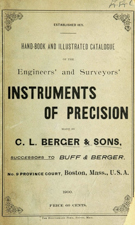
Berger - One of the major instrument makers in the late 1800s and early 1900s. Originally part of Buff & Berger.
1900 Berger
1902 Berger
1910 Berger
1913 Berger
1916 Berger
1918 Berger
1927 Berger
1947 Berger
Compleat Surveyor Instruments
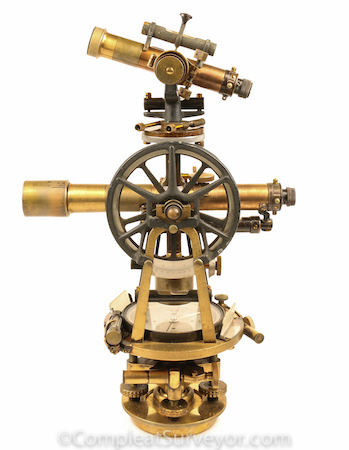
1901 Berger Solar & Mining Transit
360 Degree Spinner View
Equatorial Adapter - Rare - Known History
SOLD - Email Russ

1904 Berger Solar Transit
360 Degree Spinner View
Nice Instrument - Known Original Owner
SOLD - Email Russ
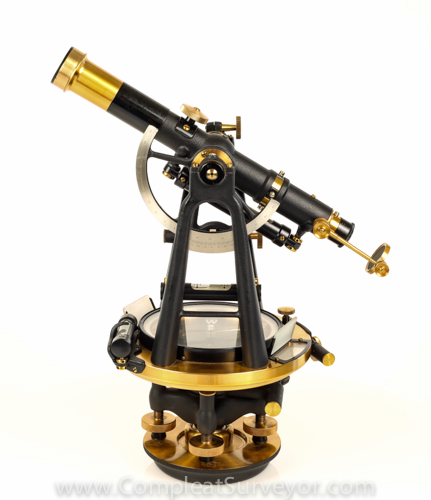
1925 Berger Transit with Davis Solar Screen
360 Degree Spinner View
Restored - Spectacular
SOLD - Email Russ
Labels
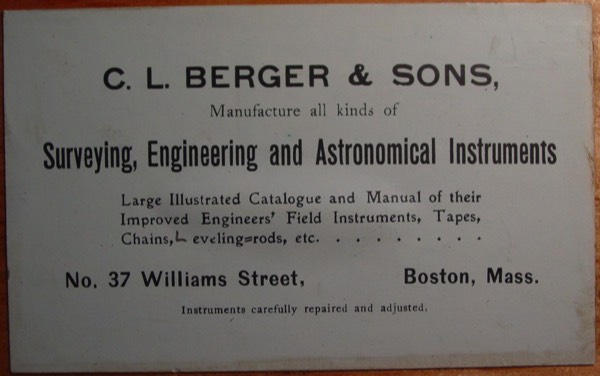
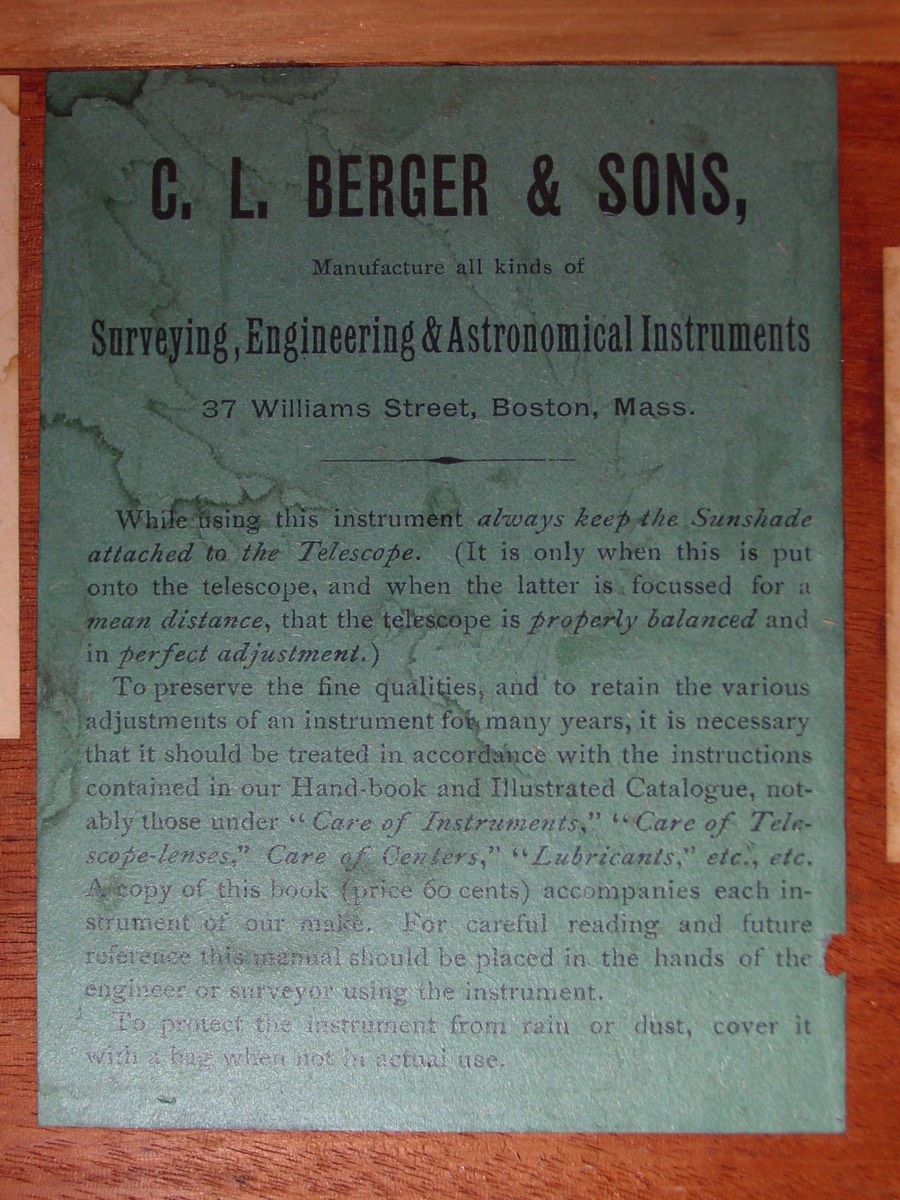
Articles
Additional Pictures
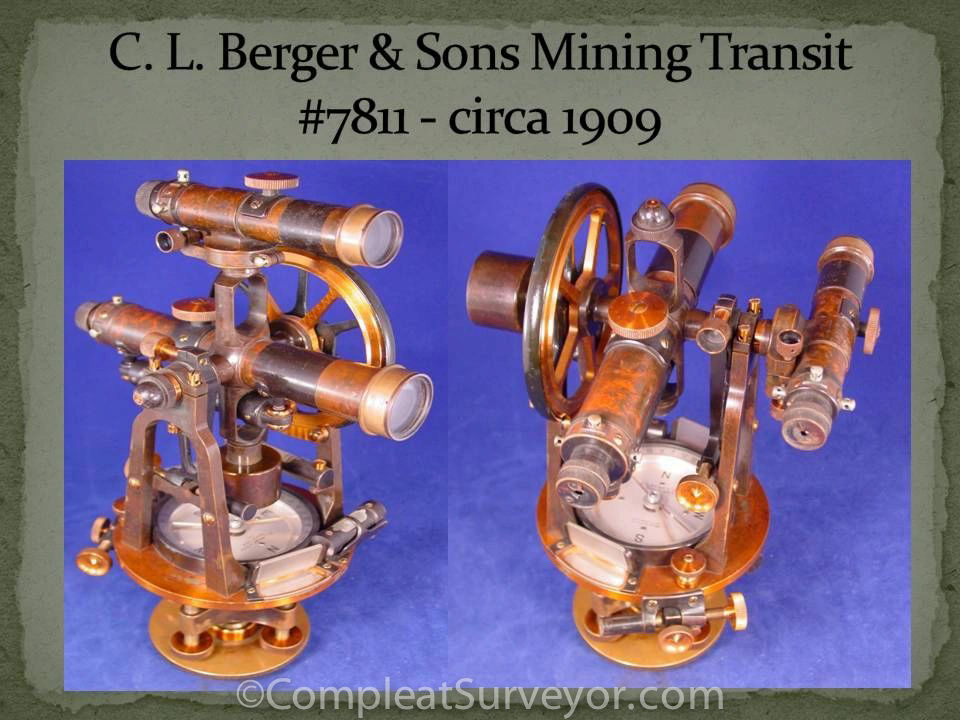
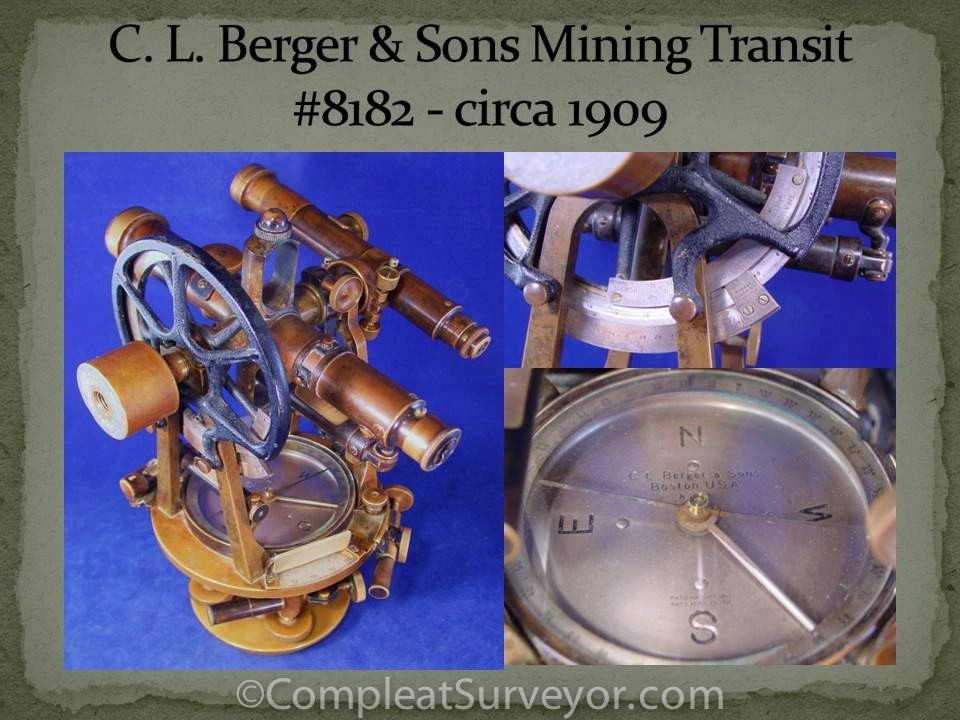


© 2020 Russ Uzes/Contact Me